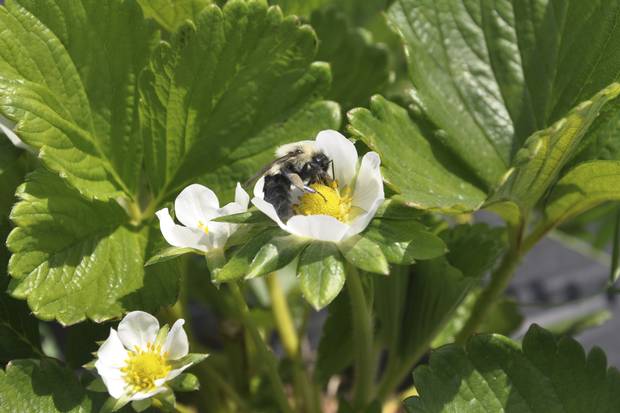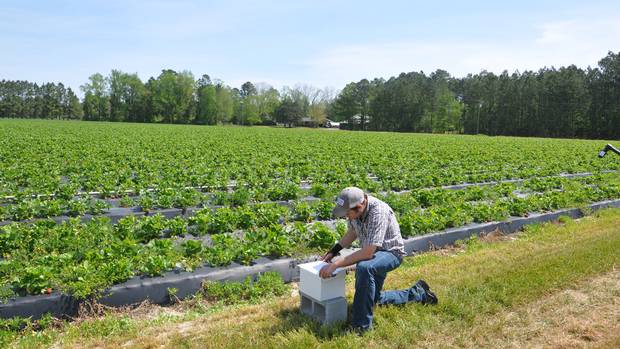
A bumblebee deposits microscopic spores of a beneficial fungus as it forages around a strawberry blossom. The Canadian-developed system is being tested as an alternative to chemical spraying.
IAN COLLINSON
Todd Mason stands among long rows of strawberry plants and taps a white box the size of a 12-pack of beer. The box starts to buzz – loudly.
"Can you hear them?" he asks.
The bumblebees are in there, and they are also flitting among the blossoms on the commercial strawberry farm. They are Mr. Mason's airborne lab assistants, helping to conduct a controlled experiment that could reap a huge success for the Canadian company behind it.
As they forage for nectar, the bumblebees are helping to fight botrytis, a fungus that afflicts strawberries both in the field and in the kitchen, reducing crop yields and contributing to food waste.
"This is what we're trying to prevent," Mr. Mason said holding up a berry from another part of the field that is coated with an unappetizing grey mould.
Drone warfare: Watch the bees’ fungus-fighting process in action
1:46
As vice-president of research at Bee Vectoring Technologies, of Mississauga, Mr. Mason is checking to see how well the company's system is doing on the small plot that the owner of a North Carolina farm has allowed him to work with.
There's plenty at stake. Farms in this region typically produce close to 16,000 kilograms of strawberries an acre. A single crop is worth hundreds of thousands of dollars.
But growers are looking for new methods of disease control because they are running out of options. The constant use of chemical fungicides has led to resistant strains of botrytis. As chemicals become less effective at controlling the fungus, there is a growing recognition that the industry needs a new approach.
That's where the bees come in.
They are the labour force the Canadian company has harnessed to spread spores of a different fungus – one that is invisible and harmless to the strawberry plants, but prevents botrytis from taking hold.
In theory, that means the strawberry plants can be spared the weekly ritual of chemical spraying for botrytis, a source of stress that impedes their growth. With less spraying, plants look fuller and taller and produce more blossoms, which translates into more berries.
Back in Mississauga, a more quantitative analysis is under way where researchers receive regular parcels with flower and leaf samples. Several farms in North America and Europe have signed on for trials of the bee-based system as the company gathers data in advance of applying for regulatory approval.
As he inspects the blossoms, John Sutton, a plant pathologist who heads the company's advisory board, appears delighted with the results. In 1988, the now retired professor began working on the beneficial fungus, called clonostachys, at the University of Guelph. His experiments soon convinced him it was an ideal – and environmentally sustainable – agent for controlling botrytis on strawberries.
The catch was how to get the clonostachys to the deepest, innermost section of each strawberry blossom – the part of the plant that eventually matures into a ripe berry. Working with another Guelph scientist, Peter Kevan, who specializes in pollination, Dr. Sutton came upon the idea of using bees to transport the clonostachys.
"They're really good delivery vehicles," said Dr. Sutton, while doing a little shimmy to demonstrate the way bees moved around a flower. "I mean, they're better than FedEx."
When the company's system is deployed, the bumblebees are purchased directly from a bee supplier. The company provides the clonostachys spores, which are mixed with a fine white powder and shipped in special trays that plop into each beehive. The bees must walk through the powder whenever they exit, carrying away some of the spores on their legs as they go.
It took Dr. Sutton and his colleagues years to isolate the most effective variety of clonostachys and learn how to generate the spores in large enough quantities for use as a biocontrol agent. Because it's a natural organism, it can't be patented. But the company has patented its system, which includes the trays and the powder.
"All of this sounded good on paper," said Greg Faust, a Colorado-based agricultural consultant who has been helping the Canadian company as it moves toward marketing its system. "Now we're putting it up against the tests and it's performing quite well."
In addition to botrytis, the company is testing its system against a range of other crop diseases, including sclerotinia, which has been devastating for sunflower crops and which currently has no effective control.
But there are hurdles to overcome. Some of the details of the system still need tweaking, and growers who are not used to working with bees must be persuaded to try working with the insects on their farms.
"The more they learn about it the more interested they are," said Scott Weathington, a North Carolina-based farmer and consultant who has been running trials for the company.

A beehive is deployed beside a strawberry field as part of a test of the system.
IAN COLLINSON
The company went public last year and is now looking to have its system approved by the U.S. Environmental Protection Agency in the next 18 months.
Meanwhile, a European competitor is now promoting a bee-based product, which increases impetus on the Canadians to generate demand for their own patented system.
"The clock is ticking now," said Michael Collinson, the Canadian company's CEO who spends much of his time flying to sites in the United States, Mexico, Croatia and Spain where trials of the system are now under way.
At its Mississauga headquarters, a custom-designed machine stands ready to start cranking out little trays of powder in mass quantities.
Mr. Collinson acknowledges it's a critical time, but expresses confidence that the company will succeed. If so, a made-in-Canada innovation could change the way many crops are managed around the world – and demonstrate that a little bee power can go a long way.
NEWS WITH BUZZ: MORE FROM THE GLOBE AND MAIL
‘Zombie bees’ numbers are growing and it’s bad news for honeybees
1:34




